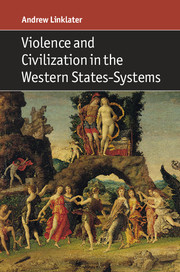Book contents
- Frontmatter
- Epigraph
- Contents
- Preface and Acknowledgements
- Introduction
- 1 The Hellenic City-States System
- 2 New Territorial Concentrations of Power in Antiquity
- 3 The International Relations of Latin Christendom
- 4 The Renaissance City-State System
- 5 The European States-System and the Idea of Civilization
- 6 Cruelty and Compassion in the Age of Empire
- 7 Enlightenment Thought and Global Civilization
- 8 Total Warfare and Decivilizing Processes
- 9 Modernity, Civilization and the Holocaust
- 10 Sovereignty, Citizenship and Humanity in the Global Civilizing Process
- 11 Process Sociology, Civilization and International Society
- Conclusion
- Bibliography
- Index
4 - The Renaissance City-State System
Published online by Cambridge University Press: 28 March 2017
- Frontmatter
- Epigraph
- Contents
- Preface and Acknowledgements
- Introduction
- 1 The Hellenic City-States System
- 2 New Territorial Concentrations of Power in Antiquity
- 3 The International Relations of Latin Christendom
- 4 The Renaissance City-State System
- 5 The European States-System and the Idea of Civilization
- 6 Cruelty and Compassion in the Age of Empire
- 7 Enlightenment Thought and Global Civilization
- 8 Total Warfare and Decivilizing Processes
- 9 Modernity, Civilization and the Holocaust
- 10 Sovereignty, Citizenship and Humanity in the Global Civilizing Process
- 11 Process Sociology, Civilization and International Society
- Conclusion
- Bibliography
- Index
Summary
In the process of transformation and innovation that we designate by the term, ‘Renaissance’, what was regarded as ‘fitting’ and ‘unfitting’ in human intercourse no doubt changed to a certain degree. But the rupture was not marked by a sudden demand for new modes of behaviour opposed to the old.
(Elias 2012: 86)Italian Renaissance thinkers invented the idea of Middle Ages to describe the period of ‘barbarism’ that intervened between classical antiquity and their era. Leading humanists regarded their epoch as one of rebirth and renewal through the discovery of ancient texts and the reacquaintance with lost traditions. The idea of the Renaissance was a mid-nineteenth-century innovation, introduced by the French historian, Michelet, to characterize an intellectual and cultural movement rather to describe a unique historical era with a definite beginning and end (Brotton 2006: 8ff.; Burke 1987). Whether the term can be usefully employed to describe a clearly delineated epoch has long been debated. In the following discussion, the Renaissance refers to the period of Italian history that lasted from around 1350 to 1550 (see Caferro 2011: 22ff.). A central issue is whether the Renaissance differed substantially from the so-called Middle Ages, or was so closely interconnected with, or indebted to, the medieval world that it is misleading to regard it as the birth of the modern era (Larkins 2010: ch. 6). Huizinga (1955) described it as a crucial phase in the waning of the Middle Ages. Nineteenth-century thinkers such as Michelet and Burckhardt portrayed the Renaissance not as a discrete epoch but as a mentality or ‘spirit’ that was centred on the rise of individuality and signified the appearance of novel understandings of what it meant to be ‘civilized’ (Brotton 2006: 9ff.).
Burckhardt's thesis that Renaissance views of ‘the state as a work of art’ and the alleged celebration of individuality were evidence of distinctively modern attitudes to the world have long been rejected. Major cultural ‘breakthroughs’ are now presented as having paved the road to ‘modernity’.
- Type
- Chapter
- Information
- Violence and Civilization in the Western States-Systems , pp. 150 - 185Publisher: Cambridge University PressPrint publication year: 2017



